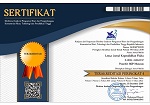PENGARUH MODEL PEMBELAJARAN PREDICT, OBSERVE, EXPLAIN, WRITE (POEW) TERHADAP PEMAHAMAN KONSEP FISIKA DITINJAU DARI JENIS KELAMIN KELAS XI IPA SMA NEGERI 1 EMPANG
DOI:
https://doi.org/10.33394/j-lkf.v3i1.335Keywords:
POEW, Gender, Conceptual UnderstandingAbstract
This study was aimed to know 1) the effect of Predict, Observe, Explain, Write (POEW) learning model toward physics conceptual understanding, 2) the effect of gender toward physics conceptual understanding, and 3) the effect of POEW learning model and gender toward physics conceptual understanding. The kind of This study was experimental research with postest only control grup design. Sample of this study were both science class 11st IPA1 and 11st IPA2 which choosen by randomizing from 3 grup of science class 11st of SMAN 1 Empang. The design of this study using factorial 2x2. The instrument of this study was essay test which have been valid and reliable to ghater information about how the physics conceptual understanding of student. Then the data of physics conceptual understanding was analysed by analysis of variance (ANOVA) using SPSS. Thus from the reshult of data we got some information were 1) the effect of POEW learning model toward physics conceptual understanding have 0,000 significance value which lower than α was 0,05. 2) the effect of gender toward physics conceptual understanding have 0,000 significance value which lower than α was 0,05. 3) the effect of interaction both POEW learning model and gender toward physics conceptual understanding have 0,002 significance value which lower than α was 0,05. It was means that POEW was affecting physics conceptual understanding based on gender at at 11st science students of SMAN 1 Empang.
References
Anderson, W.L.and Krathwol, D.R. 2001. Taxonomy for learning, Teaching, and Assessing. New York: Addison Wesley Longman, inc.
Huinker, D. dan Laughlin, C. 2001. Communication in Matematics, K-12 and Beyond. USA: NCTM.
James, A. N. 2007. Gender Differences and the Teaching of Mathematics. Virginia Community College System. (online): http://www.vccaedu.org/inquiry/inquiry-spring-2007/i-12-James.html. diakses pada tanggal 23 Maret 2013.
Joyce, B. 2009. Model-Model Pengajaran. Yogyakarta: Pustaka Pelajar.
Joyce, B. 2006. Predict, Observe, Explain (POE). (online): http://arb.nzcer.org.nz/strategies/poe.php . diakses pada tanggal 22 Mei 2014.
Kearney, Matthew dan David F. Treagust. (2000). An investigation on the classroom use of Prediction-Observation-Explanation Computer Task Designed to Elicit and Promote Discussion of student’s conception of Force and Motion. Paper presented at the 2000 National Association for research in science technical meeting, April 28-31, 2000, New Orleans, LA, USA.
Masingila, J.O dan Wisniowska, E.P (1996). Develoving and Assessing Mathematical Understanding in Calculus thorough Writing. Dalam P.C Elliot dan M.J Kenny (Eds). Yearbook Communication in Mathematics K-12 and Beyond. Reston VA: The National Council of Teacher of Mathematics.
Santrock, J.W. 2010. Psikologi Pendidikan Edisi Kedua. Jakarta: Kencana
White,R,T and Gustone, R.F.1992. Probing Understanding. Great Britain: Falmer Press.
Downloads
Published
How to Cite
Issue
Section
License
Authors who publish with Lensa: Jurnal Kependidikan Fisika agree to the following terms:
- For all articles published in Lensa: Jurnal Kependidikan Fisika, copyright is retained by the authors. Authors give permission to the publisher to announce the work with conditions. When the manuscript is accepted for publication, the authors agree to automatic transfer of the publishing right to the publisher.
- Authors retain copyright and grant the journal right of first publication with the work simultaneously licensed under a Creative Commons Attribution-ShareAlike 4.0 International License that allows others to share the work with an acknowledgment of the work's authorship and initial publication in this journal.
- Authors are able to enter into separate, additional contractual arrangements for the non-exclusive distribution of the journal's published version of the work (e.g., post it to an institutional repository or publish it in a book), with an acknowledgment of its initial publication in this journal.
- Authors are permitted and encouraged to post their work online (e.g., in institutional repositories or on their website) prior to and during the submission process, as it can lead to productive exchanges, as well as earlier and greater citation of published work (See The Effect of Open Access).

This work is licensed under a Creative Commons Attribution-ShareAlike 4.0 International License.



